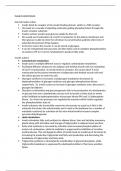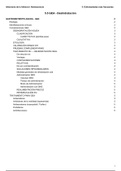INSULIN RESISTANCE
Normal insulin action.
Insulin binds its receptor at the insulin binding domain, which is a TRK receptor.
this leads to a cascade of signalling molecules getting phosphorylated, through the
insulin receptor substrate
Insulins actions would cause glucose uptake by that cell.
We would see translocation of a GLUT-4 transporter to the plasma membrane and
then glucose is able to enter the cell down its concentration gradient where lots of
potential downstream things happen.
In the liver and in the muscle, it can be stored as glycogen.
It can be metabolised into pyruvate and then fairly used in oxidative phosphorylation
to produce ATP or it can be metabolised to produce fatty acids.
Insulin actions
Carbohydrate metabolism:
Insulin acts in multiple different ways to regulate carbohydrate metabolism.
Facilitated diffusion of glucose into adipose and skeletal muscle cells via modulation
of GLUT 4 translocation. So insulin binds its receptor, this causes GLUT 4 to be
translocated to the plasma membrane of adipocytes and skeletal muscle cells and
this allows glucose to enter the cells.
Glycogen synthesis is increased, and glycogen breakdown decreased, by
dephosphorylation of glycogen synthase and glycogen phosphorylase kinase
respectively. So, insulin causes an increase in glycogen synthases and a decrease in
glycogen breakdown.
Glycolysis is stimulated and gluconeogenesis (this is the production of carbohydrates
or glucose from non-carbohydrate sources such as lactate or fatty acids or amino
acids) inhibited by dephosphorylation of pyruvate kinase (PK) and 2,6 biphosphate
kinase. So, these two processes are regulated by enzymes which insulin regulates
the phosphorylation state of.
Insulin enhances the irreversible conversion of pyruvate to acetyl co-A (this is the
molecule that enters the mitochondria and is used as the backbone for a number of
metabolic reactions) by activation of the intra-mitochondrial enzyme-complex
pyruvate dehydrogenase.
Lipid metabolism:
Insulin stimulates fatty acid synthesis in adipose tissue, liver and lactating mammary
glands along with formation and storage of triglycerides in adipose tissue and liver.
Fatty acids synthesis is increased by activation and increased phosphorylation of
acetyl-coA carboxylase, while fat oxidation is suppressed by inhibition of carnitine
acyltransferase. This anti lipogenic effect of insulin leads to a build-up of fat stores by
increasing fat production triglyceride and fatty acid production and decreasing the
breakdown of triglycerides and fatty acids.
Triglyceride synthesis is stimulated by esterification of glycerol phosphate, while
triglyceride breakdown is suppressed by dephosphorylation of hormone sensitive
lipase.
, Cholesterol synthesis is increased by activation and dephosphorylation of HMG Co-A
reductase while cholesterol ester breakdown appears to be inhibited by
dephosphorylation of cholesterol esterase
These are the normal actions of insulin on lipid metabolism on insulin sensitive
person or cell.
Protein synthesis:
Insulin promotes protein synthesis, so the build-up of amino acids into protein, in a
number of tissues.
Insulin has effects transcriptionally, several of those 300 genes will be responsible for
driving protein synthesis.
Insulin also regulates translation of MRNA into proteins in the ribosomes.
Examples of enhanced mRNA transcription include the mRNA for glucokinase, PK,
fatty acid synthase and albumin in the liver, pyruvate carboxylase in the adipose
tissue, casein in the mammary gland and amylase in the pancreas.
Insulin action decreases mRNA for liver enzymes such as carbamoyl.
Insulin resistance
Insulin resistance is defined where a normal or elevated insulin level produces an
attenuated biological response and classically this refers to impaired sensitivity to
insulin in terms of glucose disposal.
Insulin is no longer able to make cells take glucose up from the blood.
Insulin resistance and T2DM
Insulin resistance is a big component of type 2 diabetes.
Type 2 diabetes is a combination of insulin resistance, which is the elevated levels of
insulin and an attenuated response, and pancreatic beta cell dysfunction.
Pancreatic beta cells have insulin receptors on their cell surface.
Insulin feedback in an autocrine fashion to regulate insulin secretion.
Pathophysiology of insulin resistance.
Mechanisms of insulin resistance.
• The actions of insulin are influenced by the interplay of other hormones. We know
that other hormones, for example somatostatin will inhibit insulin secretion. We
know the incretins have a profound impact on insulin secretion. Glucagon also
regulates insulin secretion. There are other hormones which have an impact on
insulin levels.
• We know to some extent excess secretion of these hormones may contribute, not
just to defects in insulin secretion but also insulin resistance. The vast majority of
people with insulin resistance (people with and without type 2 diabetes), this would
not be a significant factor.
• Insulin resistance in most cases is believed to be manifested at the cellular level via
post-receptor defects in insulin signalling. The molecules that are activated when
insulin binds the insulin receptor, then auto phosphorylates, that leads to the
cascade of phosphorylation through the IRS proteins etc. It is the post receptor
elements, largely the IRS proteins which lose their function. Either they are not in
abundance, or their phosphorylation state changed or their location in the cell
Normal insulin action.
Insulin binds its receptor at the insulin binding domain, which is a TRK receptor.
this leads to a cascade of signalling molecules getting phosphorylated, through the
insulin receptor substrate
Insulins actions would cause glucose uptake by that cell.
We would see translocation of a GLUT-4 transporter to the plasma membrane and
then glucose is able to enter the cell down its concentration gradient where lots of
potential downstream things happen.
In the liver and in the muscle, it can be stored as glycogen.
It can be metabolised into pyruvate and then fairly used in oxidative phosphorylation
to produce ATP or it can be metabolised to produce fatty acids.
Insulin actions
Carbohydrate metabolism:
Insulin acts in multiple different ways to regulate carbohydrate metabolism.
Facilitated diffusion of glucose into adipose and skeletal muscle cells via modulation
of GLUT 4 translocation. So insulin binds its receptor, this causes GLUT 4 to be
translocated to the plasma membrane of adipocytes and skeletal muscle cells and
this allows glucose to enter the cells.
Glycogen synthesis is increased, and glycogen breakdown decreased, by
dephosphorylation of glycogen synthase and glycogen phosphorylase kinase
respectively. So, insulin causes an increase in glycogen synthases and a decrease in
glycogen breakdown.
Glycolysis is stimulated and gluconeogenesis (this is the production of carbohydrates
or glucose from non-carbohydrate sources such as lactate or fatty acids or amino
acids) inhibited by dephosphorylation of pyruvate kinase (PK) and 2,6 biphosphate
kinase. So, these two processes are regulated by enzymes which insulin regulates
the phosphorylation state of.
Insulin enhances the irreversible conversion of pyruvate to acetyl co-A (this is the
molecule that enters the mitochondria and is used as the backbone for a number of
metabolic reactions) by activation of the intra-mitochondrial enzyme-complex
pyruvate dehydrogenase.
Lipid metabolism:
Insulin stimulates fatty acid synthesis in adipose tissue, liver and lactating mammary
glands along with formation and storage of triglycerides in adipose tissue and liver.
Fatty acids synthesis is increased by activation and increased phosphorylation of
acetyl-coA carboxylase, while fat oxidation is suppressed by inhibition of carnitine
acyltransferase. This anti lipogenic effect of insulin leads to a build-up of fat stores by
increasing fat production triglyceride and fatty acid production and decreasing the
breakdown of triglycerides and fatty acids.
Triglyceride synthesis is stimulated by esterification of glycerol phosphate, while
triglyceride breakdown is suppressed by dephosphorylation of hormone sensitive
lipase.
, Cholesterol synthesis is increased by activation and dephosphorylation of HMG Co-A
reductase while cholesterol ester breakdown appears to be inhibited by
dephosphorylation of cholesterol esterase
These are the normal actions of insulin on lipid metabolism on insulin sensitive
person or cell.
Protein synthesis:
Insulin promotes protein synthesis, so the build-up of amino acids into protein, in a
number of tissues.
Insulin has effects transcriptionally, several of those 300 genes will be responsible for
driving protein synthesis.
Insulin also regulates translation of MRNA into proteins in the ribosomes.
Examples of enhanced mRNA transcription include the mRNA for glucokinase, PK,
fatty acid synthase and albumin in the liver, pyruvate carboxylase in the adipose
tissue, casein in the mammary gland and amylase in the pancreas.
Insulin action decreases mRNA for liver enzymes such as carbamoyl.
Insulin resistance
Insulin resistance is defined where a normal or elevated insulin level produces an
attenuated biological response and classically this refers to impaired sensitivity to
insulin in terms of glucose disposal.
Insulin is no longer able to make cells take glucose up from the blood.
Insulin resistance and T2DM
Insulin resistance is a big component of type 2 diabetes.
Type 2 diabetes is a combination of insulin resistance, which is the elevated levels of
insulin and an attenuated response, and pancreatic beta cell dysfunction.
Pancreatic beta cells have insulin receptors on their cell surface.
Insulin feedback in an autocrine fashion to regulate insulin secretion.
Pathophysiology of insulin resistance.
Mechanisms of insulin resistance.
• The actions of insulin are influenced by the interplay of other hormones. We know
that other hormones, for example somatostatin will inhibit insulin secretion. We
know the incretins have a profound impact on insulin secretion. Glucagon also
regulates insulin secretion. There are other hormones which have an impact on
insulin levels.
• We know to some extent excess secretion of these hormones may contribute, not
just to defects in insulin secretion but also insulin resistance. The vast majority of
people with insulin resistance (people with and without type 2 diabetes), this would
not be a significant factor.
• Insulin resistance in most cases is believed to be manifested at the cellular level via
post-receptor defects in insulin signalling. The molecules that are activated when
insulin binds the insulin receptor, then auto phosphorylates, that leads to the
cascade of phosphorylation through the IRS proteins etc. It is the post receptor
elements, largely the IRS proteins which lose their function. Either they are not in
abundance, or their phosphorylation state changed or their location in the cell




